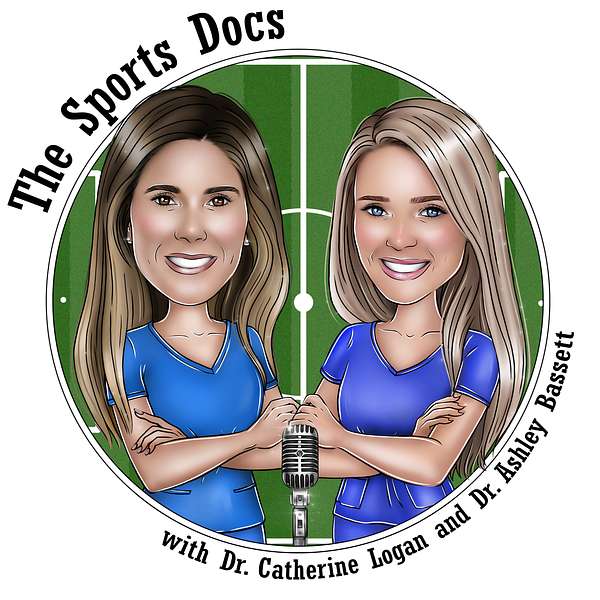
The Sports Docs Podcast
Sports medicine is a constantly evolving field, with hundreds of new articles published each month on the topic. This ever-growing wealth of information can make it challenging to stay updated on the newest approaches and techniques, and to know which data should actually change your practice. Join orthopedic surgeons, Dr. Catherine Logan and Dr. Ashley Bassett, as they chat about the most recent developments in sports medicine and dissect through all the noise.
On each episode of The Sports Docs podcast, the hosts will tackle a specific injury – from ACL tears to shoulder instability – and review the top research from various high-impact journals that month, including The American Journal of Sports Medicine, Arthroscopy: The Journal of Arthroscopic and Related Surgery, Sports Health, Journal of Shoulder and Elbow Surgeons, and more. The Sports Docs will also be joined by experts in the field of sports medicine – orthopedic surgeons, nonoperative sports medicine specialists, athletes, physical therapists, athletic trainers and others – to provide a fresh and well-rounded perspective based on their unique experiences.
The Sports Docs – Dr. Logan & Dr. Bassett – are friends & former co-residents from the Harvard Combined Orthopaedic Residency Program, who went onto esteemed sports medicine fellowships at The Steadman Clinic and The Rothman Institute, respectively. Dr. Logan practices in Denver, CO, and serves as Team Physician for Men's USA Lacrosse & as a Team Physician for U.S. Ski & Snowboard. Dr. Bassett is the director of the Women’s Sports Medicine Center at the Orthopedic Institute of New Jersey and practices across northern NJ, primarily in Morris and Sussex Counties.
Together, they will bring monthly conversations on how to care for athletes of all ages and levels of play, with a healthy mix of cutting-edge science and real-world application.
The Sports Docs Podcast
11. Dr. Eddie Chang: Blood Flow Restriction Therapy - Part I
Hi everyone. Before we kick off our episode today, we must start with some sad news. The orthopedic community suffered a tremendous loss this past Friday with the passing of Dr. Freddie Fu. Dr. Fu was a giant in the field of sports medicine and touched the lives of countless patients and athletes around the world. He mentored generations of orthopedic surgeons, many of whom went on to also become leaders in the field of sports medicine and carry his legacy onward. Thank you, Dr. Fu. You will be profoundly missed.
On today’s episode we’re focusing on blood flow restriction therapy or “BFR”. Blood flow restriction is one type of ischemic therapy that is thought to increase muscle mass, strength and performance at a lower level of resistance training. And that last part really is the key, because training at high loads is often not possible for our patients undergoing rehab for an injury or postoperatively.
BFR involves the use of a cuff or tourniquet system positioned at the upper part of the limb to restrict venous blood return while maintaining arterial inflow. While the exact mechanism of BFR remains unclear, restriction of venous outflow leads to an anaerobic – or oxygen depleted – environment similar to that of higher-intensity training. This anaerobic environment is hypothesized to promote muscle hypertrophy through a combination of cell signaling and hormonal changes.
BFR is not for every patient and there are relative contraindications to its use. These include conditions that may increase the risk of blood clotting, such as vascular disease, obesity, sickle cell trait or disease, cancer and a history of DVT.
We’re joined today by Dr. Edward Chang, orthopedic surgeon and director of research at Inova Sports Medicine. Dr. Chang recently won the O’Donoghue Sports Injury research award for his work on the use of BFR after ACL reconstruction, so we are very excited to have him join our discussion today.
We have some great articles for you today that contribute well to our conversation on the use of blood flow restriction therapy for both routine training and after musculoskeletal injury or surgery. As always, links to all of the papers that we discuss on this show can be found on our podcast website.
The first article is a systematic review recently published by Mary Mulcahey and colleagues in the June issue of AJSM this year, titled Blood Flow Restriction Training in Athletes. This paper analyzed the effects of BFR training compared to traditional resistance training in healthy athletes. 78% of the included studies reported a significant increase in muscle strength after BFR compared to traditional training. 3 of the 4 studies that evaluated sports specific performance reported significant improvement across various running, jumping, endurance and agility tests compared to controls. The effect of BFR on muscle mass, however, was less clear. Of the 8 studies, 50% found a significant increase in muscle size while 50% reported no difference between the groups.
Though there was no difference found in 50% of those studies, an argument can be made that achieving equivalent muscle mass at lower loads is still a win. Another take-away from this paper was the incredible variability across the BFR protocols that were used in these studies. They varied widely in terms of duration of training, frequency of sessions, intensity of exercise, number of repetitions performed, length of occlusion and rest periods, body part and cuff pressure measurements, with some studies simply using an elastic band applied to perceived resistance, known as “practical BFR”. Moving forward, future studies should aim to clarify the optimal BFR protocol for different body parts and different patient populations. The BFR protocol for someone who is training is likely to be different than the protocol for an athlete recovering from injury.
Our second article is a laboratory study from